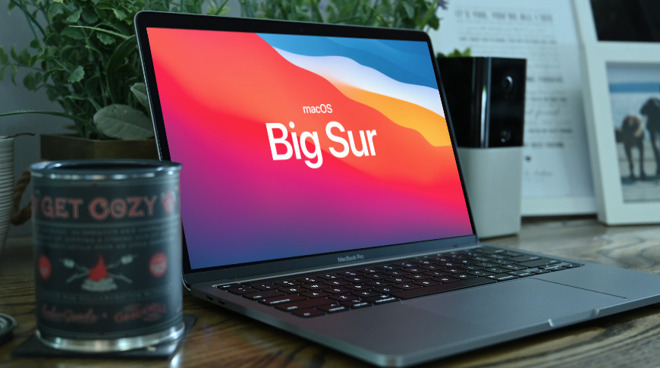Apple addresses macOS Big Sur upgrade issues impacting 2013 and 2014 MacBook Pro models
Apple on Thursday published a support document detailing steps users should take if they encounter problems installing macOS Big Sur on certain MacBook Pro models.

According to reports earlier this week, some users are facing issues when installing Big Sur on their 13-inch MacBook Pro from late 2013 or mid 2014.
Specifically, updates in some cases result in a permanent black screen or a screen bearing a circle with a line through it, a problem that does not resolve itself when restarting the machine in Safe Mode. Attempts to use Apple's Internet Recovery tool have also been unsuccessful.
Apple in today's Support Pages document acknowledges the issue and offers a potential workaround.
If an impacted Mac does not start properly, Apple says to:
Resetting NVRAM and PRAM requires users to shut down their machine, hold Option, Command, P, and R until the Apple logo appears and disappears twice, or about 20 seconds.
Apple instructs MacBook owners to contact Apple Support if the above techniques do not work. The company adds that the Support Pages document will be updated when it has a more comprehensive solution.
Big Sur saw release last week, but the launch was quickly marred by installation, app runtime and cascading server issues.

According to reports earlier this week, some users are facing issues when installing Big Sur on their 13-inch MacBook Pro from late 2013 or mid 2014.
Specifically, updates in some cases result in a permanent black screen or a screen bearing a circle with a line through it, a problem that does not resolve itself when restarting the machine in Safe Mode. Attempts to use Apple's Internet Recovery tool have also been unsuccessful.
Apple in today's Support Pages document acknowledges the issue and offers a potential workaround.
If an impacted Mac does not start properly, Apple says to:
- Press and hold the power button on your Mac for at least 10 seconds, then release. If your Mac is on, it turns off.
- Unplug all external devices from your Mac, including any displays and USB accessories, and remove any card inserted in the SDXC card slot. Then turn your Mac on.
- If the issue persists, reset the SMC as described for notebook computers with a nonremovable battery.
- If the issue persists, reset NVRAM or PRAM.
Resetting NVRAM and PRAM requires users to shut down their machine, hold Option, Command, P, and R until the Apple logo appears and disappears twice, or about 20 seconds.
Apple instructs MacBook owners to contact Apple Support if the above techniques do not work. The company adds that the Support Pages document will be updated when it has a more comprehensive solution.
Big Sur saw release last week, but the launch was quickly marred by installation, app runtime and cascading server issues.

Comments
I think I’ll wait for a software fix from Apple, even if it takes weeks. Are the new features in Big Sur really worth it?
It’s the same thing as with Catalina last year .
That may all change once I get a new MBP 16" sometime next year, though.
If that wasn't enough, my new Iphone SE has bugs too. When using the phone there are no buttons to mute the phone or put it on the speaker. Today after an upgrade those buttons are still missing. You can count me as someone going back to an Android.
I have since reinstalled Catalina but the boot problem still persists. Something has happened to the firmware during the Big Sur install. Advice to reset NVRAM/PRAM or SMC does little good, though it may have eventually given me back the chime, even if it never got any further than that.
I've run in verbose mode to see if I could track down from the system log anything that might be causing the problem. But the boot process never reaches the point of logging anything. So my system log only showed successful boot and shutdowns with none of the failed in-between attempts!
What I've found is that if I leave the MBP switched on at the black screen, plugged in to AC, eventually it will boot. I think it may need to be physically hot before it will boot - this can take anything from 1 to 4 hours! I haven't quite pinned it down. I just keep checking every hour or so if I can press the power button to shut down and then boot up. I am typing this message on my MBP after it going "black" for about an hour and a half between shutdown and reboot.
I had an appointment with an authorise repair service today, only to be told that if it's a hardware problem, then it can't be fixed as it's a "vintage" model. Hopefully the engineers will track down the issue and a future revision to Big Sur will fix it. Until then, I won't be shutting down unless absolutely necessary, and will continue using Catalina.
I finally came across an article that suggested that I add the openDNS IP address. I did so and was able to connect. However, after removing the openDNS IP address, I was unable to connect again. Then, I noticed in the DNS panel of the advanced section of my network settings that there were two IP addresses filled. I recognized them as addresses that were generated by my wireless router and was unclear why they were filled in the panel, because they should be selected based on availability or dynamically for Ethernet. So, I deleted the IP addresses from the DNS panel and the problem now appears to be completely resolved. I am able to connect via Wi-Fi and ethernet.
To do what I did, go to the network section of system preferences and select ethernet and advanced and remove the IP addresses from the DNS panel and then do the same thing for Wi-Fi.